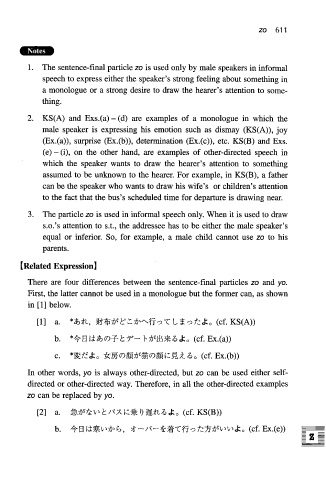Page 685 - Makino,Tsutusi.DictionaryOfIntermediateJGrammar
P. 685
-
1. The sentence-final particle zo is used only by male speakers in informal
speech to express either the speaker's strong feeling about something in
a monologue or a strong desire to draw the hearer's attention to some-
thing.
2. KS(A) and Exs.(a) - (d) are examples of a monologue in which the
male speaker is expressing his emotion such as dismay (KS(A)), joy
(Ex.(a)), surprise (Ex.@)), determination (Ex.(c)), etc. KS(B) and Exs.
(e) - (i), on the other hand, are examples of other-directed speech in
which the speaker wants to draw the hearer's attention to something
assumed to be unknown to the hearer. For example, in KS(B), a father
can be the speaker who wants to draw his wife's or children's attention
to the fact that the bus's scheduled time for departure is drawing near.
3. The particle zo is used in informal speech only. When it is used to draw
s.o.'s attention to s.t., the addressee has to be either the male speaker's
equal or inferior. So, for example, a male child cannot use zo to his
parents.
There are four differences between the sentence-final particles zo and yo.
First, the latter cannot be used in a monologue but the former can, as shown
in [I] below.
[I] a. *hi%, %&W~Z+-?~QT La 37?.k0 (cf. KS(A))
b. *+HC;lrhD327-bd"X%bkO (cf.Ex.(a))
c. *@I?&, kEDafid"bD&3KR;ibo (cf. Ex.(b))
In other words, yo is always other-directed, but zo can be used either self-
directed or other-directed way. Therefore, in all the other-directed examples
zo can be replaced by yo.
[2] a. %A%blkltXG:;i9i!I BkLbkO (cf. KS(B))

